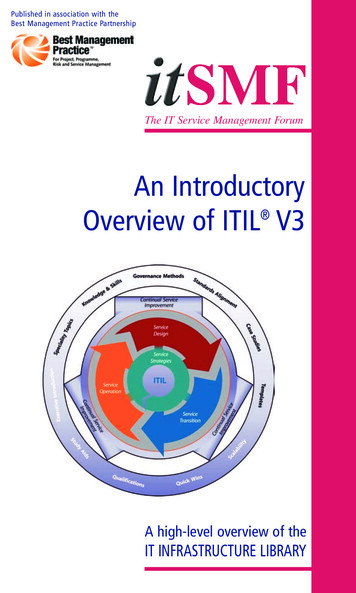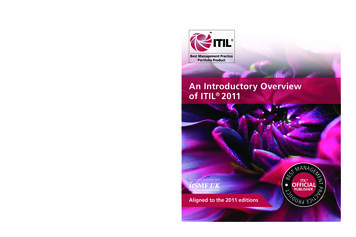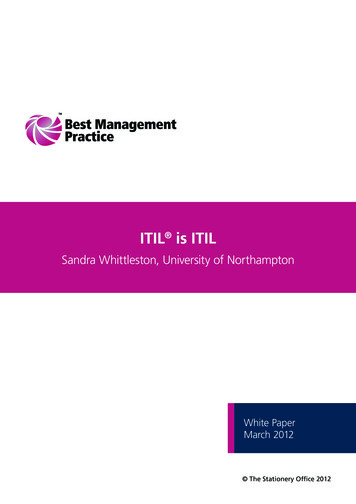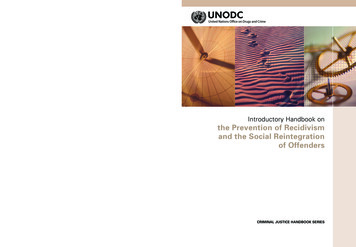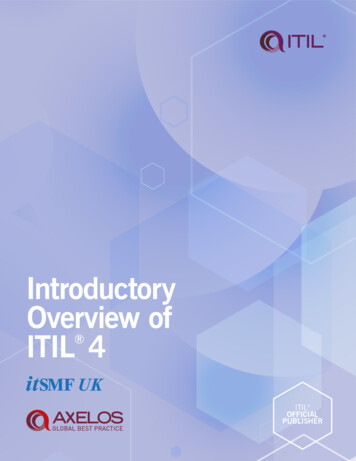
Transcription
Introductory Overview of ITIL 4IntroductoryOverviewof ITIL 4ITIL OFFICIALPUBLISHERi
Published by TSO (The Stationery Office), part of Williams Lea,and available from:Onlinewww.tsoshop.co.ukMail, Telephone, Fax & E-mailTSOPO Box 29, Norwich, NR3 1GNTelephone orders/General enquiries: 0333 202 5070Fax orders: 0333 202 5080E-mail: customer.services@tso.co.ukTextphone 0333 202 5077TSO@Blackwell and other Accredited AgentsCopyright AXELOS Limited 2020All rights reserved. No part of this publication may be reproduced in any form or by any meanswithout permission in writing from AXELOS Limited.Applications to reuse, reproduce or republish material in this publication should be sent to thelicensing team at: licensing@AXELOS.comRegistered office address: 30 Berners Street, London, England, W1T 3LRAXELOS, the AXELOS logo, the AXELOS swirl logo, AgileSHIFT , ITIL , MoP , M o R , MoV ,MSP , P3M3 , P3O , PRINCE2 , PRINCE2 Agile , and RESILIA are registered trade marks ofAXELOS Limited.10/20
ContentsAcknowledgementsviAbout this guidevii1Introduction12What is service management?43What is ITIL?64Key concepts of ITIL 485The four dimensions of service management5.1 Organizations and people6115.2 Information and technology115.3 Partners and suppliers125.4 Value streams and processes125.5 External factors13The ITIL service value system146.1 The ITIL guiding principles710156.2 Governance196.3 Service value chain206.4 ITIL management practices226.5 Continual improvement24The ITIL 4 certification scheme277.1 ITIL Foundation277.2 ITIL Managing Professional stream287.3 ITIL Strategic Leader stream327.4 ITIL Master337.5 ITIL and the T-shaped individual34iv
Introductory Overview of ITIL 489Related guidance378.1 Best-practice frameworks378.2 Service management standard39Summary40Further information42Contact points43v
AcknowledgementsAuthorAlison CartlidgeSopra SteriaReviewersBarry CorlessIndependent consultantRosemary GurneyGlobal KnowledgeMark LillycropitSMF UKVernon LloydSomerset CC LtdNargis MirzaUK Home OfficeBarclay RaeIndependent consultantvi
About this guideITIL provides a framework of best-practice guidance for IT servicemanagement and, since its creation, ITIL has grown to become themost widely accepted approach to IT service management in the world.This pocket guide has been designed as an introductory overview foranyone who has an interest in or a need to understand more about ITIL 4and its qualification scheme. While this guide provides an overview, fulldetails can be found in the actual ITIL 4 publications themselves.The guidance contained within this publication is neither definitive norprescriptive, but is based on ITIL best practice. The guidance in theITIL publications is applicable generically and is of benefit to all ITorganizations, irrespective of their size or the technology in use. ITILbest practice is neither bureaucratic nor unwieldy if utilized sensiblyand in full recognition of the business needs of the organization.Note that this is an overview publication, and is not designed to replaceofficial guidance or support training. Further information can be foundat l.vii
1IntroductionInformation is increasingly recognized as the most important strategicresource that any organization has to manage. Key to the collection,analysis, production, and distribution of information within anorganization is the quality of the IT services provided to the business.Services create and provide value for organizations and their customers.Most services today are IT-enabled, which means that the quality of ITservice management capabilities can impact the level of value achieved.Technology advancements mean that IT has become a significantbusiness driver, often delivering competitive advantage, raising the profileof IT service management to a strategic capability. To remain successful,many organizations are undertaking major transformational programmesto exploit these opportunities, often referred to as ‘digital transformations’.Through such transformations, information and technology are becomingfully integrated across organizations, breaking down silos and driving anincreasing need for operational agility and velocity.Service management is evolving to address and support theseorganizational needs. As service management is evolving, so is ITIL,the most widely adopted guidance on IT service management in theworld. ITIL advocates that IT services should be aligned with the needsof the business and support its core processes.ITIL provides guidance and helps service providers to: support business objectives enable business change manage risk in line with business needs optimize customer experience1
Introductory Overview of ITIL 4 facilitate value for money drive operational agility and velocity leverage digital services drive continual improvement.ITIL 4 provides a holistic framework for best-practice IT servicemanagement. It introduces the service value system (SVS) to representhow different components and activities of the organization worktogether to facilitate value creation through IT-enabled services.Within this guidance: Chapter 1 gives a general introduction Chapter 2 introduces the concept of service management Chapter 3 presents an introduction to ITIL best practice Chapter 4 provides an overview of the key concepts that underpinITIL 4 Chapter 5 outlines the four dimensions of service management andtheir key role in effective services Chapter 6 outlines the SVS, including: the ITIL guiding principles, which can guide an organization’sdecisions and actions, ensuring a shared understanding andcommon approach to service management across theorganization the ITIL service value chain (at the heart of the SVS), whichdefines interconnected activities that an organization performsto deliver a valuable product or service to its consumers and tofacilitate value realization the ITIL management practices, comprising the organizationalresources designed for performing work or accomplishing anobjective2
Introduction Chapter 7 outlines the ITIL 4 certification scheme, providing amodular approach to the ITIL framework, allowing candidates tofocus their studies on key areas of interest Chapter 8 describes related guidance useful for further information Chapter 9 summarizes ITIL 4 and the benefits it can deliver.ITIL’s capabilities provide a range of key benefits for both theorganization and the professional.3
2 What is service management?To understand what service management is, we need to understandwhat services are, and how service management can help organizationsto deliver and manage these services. Definition: ServiceA means of enabling value co-creation by facilitating outcomes thatcustomers want to achieve, without the customer having to managespecific costs and risks.The services that an organization provides are based on one or more ofits products. Organizations own or have access to a variety of resources,including people, information and technology, value streams andprocesses, and suppliers and partners. Products are configurations ofthese resources, created by the organization, that will potentially bevaluable for its customers.Service management enables a service provider to understand theservices it is providing, ensuring that the services really do facilitate theoutcomes its customers want to achieve. It also enables the serviceprovider to understand the value delivered by these services, and tomanage all of the costs and risks associated with them.4
Definition: Service managementA set of specialized organizational capabilities for enabling value forcustomers in the form of services.Developing the specialized organizational capabilities mentioned in thedefinition requires an understanding of: the nature of value the nature and scope of the stakeholders involved how value creation is enabled through services.The ITIL SVS addresses these needs and enables the co-creation ofvalue through the delivery of products and services.Adopting best practice can help a service provider to create an effectiveservice management system. Best practice is simply doing things thathave been shown to work and to be effective. Best practice can comefrom many different sources, including frameworks (such as ITIL,COBIT and SIAM ), standards (such as ISO/IEC 20000 andISO 9000), and proprietary knowledge of people and organizations.5
3What is ITIL?ITIL is a framework that describes best practice in IT service management,drawn from international public and private sectors. It provides aframework of comprehensive, practical, and proven guidance forestablishing an IT service management system, encouraging consistencyand continual improvement for businesses using IT-enabled services.ITIL is the globally recognized leader in IT service management. It offerscommon concepts and vocabulary, aligned with international standards,to ease collaboration across departments, organizations, geographies,and providers. This results in increased effectiveness and efficiency,delivering value across the business.ITIL enables organizations and individuals to gain optimal value from ITand digital services. It helps to define the direction of a service providerwith a clear capability model, and aligns it with the business strategyand customer needs.ITIL was initially developed in the 1980s, and consisted of a library ofseveral books covering all aspects of IT service provision. Its early usewas principally confined to the UK and The Netherlands. Between2000 and 2004 this initial version was revised and replaced by ITILV2, consisting of two core publications covering 10 processes and theservice desk, supported by a number of closely connected booksconsolidated within an overall framework.Following a major ‘refresh’, ITIL v3 was published in 2007, consistingof five core publications covering the service lifecycle, with an updatein 2011. Each of the five core publications covered a stage of theservice lifecycle, from the initial strategy and design (ITIL ServiceStrategy and ITIL Service Design), through migration into the liveenvironment (ITIL Service Transition), to live operation and improvement6
(ITIL Service Operation and ITIL Continual Service Improvement).The service lifecycle provided a framework to manage the end-to-endlifecycle of services, consisting of 26 processes, supported by fourorganizational functions, and aligned with the ISO/IEC 20000 ServiceManagement standard.ITIL 4 is the latest evolution of ITIL. Launched in 2019, it reshapes theestablished ITIL practices in the wider context of customer experience,value streams, and digital transformation, while embracing new ways ofworking, such as Lean, Agile, and DevOps. It ensures continuity withexisting ways of working (where successful) by integrating modern andemerging practices with established and proven know-how, andprovides guidance on the benefits and adoption of these new methodswith minimal disruption.ITIL 4’s holistic approach elevates the profile of service management inan organization to a more strategic level, focusing on delivering value,while offering a flexible, coordinated, and integrated system for theeffective governance and management of IT-enabled services. The ITILpublications are, however, just the starting point for ITIL.ITIL 4 is a professionally recognized certification scheme, providing astructured approach for developing IT service managementcompetencies. As it has evolved from ITIL v3, there is a clear transitionpath from one scheme structure to the other, enabling practitioners tocontinue their ITIL journey. There is also a range of complementarypublications and guidance, including: qualification scheme guidance and syllabuses revision guides, such as ITIL 4 Foundation Revision Guide white papers and case studies MyITIL (available via subscription) with supplementary contentssuch as tutorials, templates and ITIL management practices.For more details see https://www.axelos.com/itil.7
4Key concepts of ITIL 4The purpose of an organization is to create value for stakeholders.Value is defined as the perceived benefits, usefulness, and importanceof something, and is co-created through active collaboration betweenservice providers, consumers, and other organizations within theservice relationships.Service providers can be internal and/or external.Service consumers can include customers who define servicerequirements and are responsible for service outcomes; users whoconsume the service; and a sponsor who authorizes the budget forservice consumption.A service relationship is defined as the cooperation between a serviceprovider and service consumer; this includes service provision, serviceconsumption, and service relationship management. In a servicerelationship, organizations can be service providers or serviceconsumers. However, these roles are not mutually exclusive;organizations can both provide and consume services at any given time.Service providers help their consumers to achieve outcomes. Achievingdesired outcomes requires resources (costs) and often risks. Therefore,service providers can take on some of the associated risks and costsfrom service consumers. Service relationships can also introduce newrisks and costs, which can sometimes negatively affect some of theintended outcomes while supporting others.Figure 4.1 shows that achieving outcomes is a balancing act. Servicerelationships are only seen as valuable when there are more positivethan negative effects for all parties involved.8
Figure 4.1 Achieving value: outcomes, costs, and risksTo offer value to a customer, an organization designs services based onone or more of its products. Products are created through combinationsof an organization’s resources, including people, information andtechnology, value streams and processes, and suppliers and partners.The value of a product or service to a customer is influenced by thecombination of its utility (its fitness for purpose) and its warranty (itsfitness for use). Both utility and warranty must exist to provide value tothe customer, because customers cannot derive benefit from somethingthat is fit for purpose but not fit for use (or vice versa).These key concepts, which underpin the ITIL 4 framework, apply to allorganizations and services, regardless of their nature or technology.9
5 he four dimensions of serviceTmanagementThere are four dimensions of service management, as illustrated inFigure 5.1.PoliticalfactorsOrganizationsand peopleEconomicfactorsInformationand technologyProductsand nd suppliersLegalfactorsValue streamsand processesTechnologicalfactorsFigure 5.1 The four dimensions of service managementThese four dimensions provide different perspectives of servicemanagement. Together they support a holistic approach that impacts allareas of the SVS. Unless all four dimensions are addressed, anorganization might fail to achieve its desired outcomes. For example,process improvements without proper consideration for people, partnersor technology, or technology that is implemented without due care forpeople or processes, might result in services becoming undeliverable orinefficient to run.10
However, no organization operates in isolation, and Figure 5.1 shows arange of external factors that can affect each dimension. Organizationsshould ensure a balanced focus between each dimension.5.1 Organizations and peopleOrganizations are becoming ever-more complex; therefore they needto be structured and managed with care, and their culture needs to bealigned with their objectives and the right level of human capabilityand capacity.An organizational structure can also include customers, service providers,supplier employees, and other stakeholders in the service relationship.People considerations for an organization should include such aspectsas managing skills and competencies, clear roles and responsibilities,leadership styles and communications, and a culture that encouragescollaboration, helping individuals to understand their contribution in thecreation of value for customers and stakeholders.5.2 Information and technologyThis dimension considers the information and knowledge needed, alongwith the technologies required, to both manage and deliver the services.Technologies that support service management encompass applications,databases, communications, workflow systems, and knowledge bases,complemented by new techniques and developments such as artificialintelligence, mobile platforms, and cloud computing. The culture andnature of the business will impact the choice of technologies used.For a specific IT service, this includes the information created,protected, managed, used, and archived in the course of serviceprovision and consumption.11
Introductory Overview of ITIL 4For many services, information management is the primary means ofenabling customer value (e.g. by enabling an organization to access andmaintain accurate information).This dimension also considers challenges such as security andregulatory compliance.5.3 Partners and suppliersThis dimension considers an organization’s relationships, contracts, andagreements with other organizations involved in the design, delivery,and support of services.Every organization and every service depend to some extent on theservices provided by other organizations. Relationships betweenorganizations can vary in levels of integration and formality, rangingfrom formal service provider or customer contracts, to flexiblepartnerships where parties may work together. One model anorganization can use to address this dimension is service integrationand management (SIAM).Key factors involved in making the right sourcing and suppliermanagement decisions are considered, such as strategic focus,corporate culture, cost effectiveness, specialist knowledge, and variabledemand for services.5.4 Value streams and processesThis dimension defines the activities, workflows, controls, and proceduresneeded to achieve agreed objectives. Value streams and processes areconcerned with how the various parts of the organization work together toenable value creation through products and services (i.e. how the deliverymodel for a service works to achieve agreed outcomes).12
The four dimensions of service managementA value stream is a series of steps undertaken to create and deliverproducts and services to consumers. Reviewing and mapping valuestreams can help an organization to identify opportunities toimprove productivity.A process is a set of interrelated activities that transform inputs intooutputs. Processes define the sequence of actions, their dependencies,and who is involved, with work instructions describing how the activitiesare carried out.5.5 External factorsService providers do not operate in isolation; they are influenced byexternal factors that can impact how the dimensions operate. Theseinclude political, economic, social, technological, legal, andenvironmental factors (PESTLE), as shown in Figure 5.1.These external factors constrain or influence how organizations addressthe four dimensions of service management.13
6The ITIL service value systemThe ITIL SVS, as illustrated in Figure 6.1, shows how the keycomponents and activities in a service work together to create anddeliver value. The SVS enables integration, coordination, and a unifiedvalue-driven focus across the organization.The SVS is triggered by opportunities (to add value) or demand frominternal and external sources. This in turn enables value co-creation for awide group of stakeholders through the delivery of products and services.Each organization’s SVS has interfaces with other organizations. Theseform an ecosystem that can facilitate value for all those organizations,their customers, and other stakeholders.Opportunity/demandFigure 6.1 The ITIL service value system14
6.1 The ITIL guiding principlesA guiding principle is a recommendation that guides an organizationin all circumstances, regardless of changes in its goals, strategies, typeof work, or management structure. A guiding principle is universaland enduring.The guiding principles, as shown in Figure 6.2, embody the coremessages of ITIL and service management, creating the foundation foran organization’s culture and behaviour, from strategic decision-makingto day-to-day operations in general. They also promote and supportcontinual improvement across and at all levels within an organization.Start whereyou areFocuson valueProgressiterativelywith feedbackThink andwork holisticallyCollaborateand promotevisibilityKeep it simpleand practicalOptimizeand automateFigure 6.2 The ITIL guiding principles15
Introductory Overview of ITIL 46.1.1Focus on valueThe core of this principle is that everything an organization does needsto map, directly or indirectly, to value for itself, its customers, and itsother stakeholders. This means that the service provider needs tounderstand who is being served and what is of value to the serviceconsumer; for example, this could be improved productivity, a morecompetitive position, reduced costs, meeting regulatory requirements,and/or the ability to pursue new markets.Service consumers define value based on their own needs, and achieveit by contributing to the intended outcomes and optimizing their costsand risks.The experience that service consumers have when they interact withthe service and service provider is also an important aspect of value,frequently called customer experience (CX) or user experience (UX).CX is objective and subjective, and contributes to customer feelingsabout the organization, its products, and its services, so needs to beactively managed.6.1.2Start where you areThe focus for this principle is that when creating something better, itcan be tempting to start from scratch and build something completelynew, eliminating old and unsuccessful methods. Not only can thisapproach waste time, but it can also lead to the loss of existingservices, processes, people, and tools that could have significant valuein the improved service. Before starting again, it is better to considerwhat is already available to be leveraged.Organizations need to measure and understand the current capability todetermine what can be re-used, ensuring that any measurementsrepresent an accurate view; for example, there may be discrepancies16
The ITIL service value systembetween reality and reports, or measures may not focus on the rightaspects of service provision, driving poor behaviours.6.1.3Progress iteratively with feedbackObserving this principle involves resisting the temptation to doeverything at once. Even huge initiatives should be broken down andaccomplished iteratively. Organizing work into smaller, manageablesections improves control and focus so they can be executed andcompleted in a timely manner.Iterations can be timeboxed; they can be sequential or simultaneous,depending on the requirements and resources available. An iterativeapproach can deliver tangible results faster to the customer andbusiness. Feedback can be used to improve the quality of iterations andto identify improvement opportunities, risks, and issues.6.1.4Collaborate and promote visibilityThe basis of this principle is that when initiatives involve the rightpeople in the correct roles, the initiative benefits through better buy-in,more relevance (because better information is available for decisionmaking), and an increased likelihood of long-term success.Collaborating across boundaries achieves greater engagement, support,and commitment from all stakeholders, improving their alignment andcontribution towards objectives. This generates enduring outcomes thatsuccessfully deliver long-standing benefits.Making work visible and sharing information across stakeholderssupports a culture of openness, transparency, and trust, whereasinsufficient visibility can introduce challenges and risks, includingmisunderstandings, hidden agendas, and poor decision-making.17
Introductory Overview of ITIL 46.1.5Think and work holisticallyThe essence of this principle is that no service, practice, process,department, or supplier stands alone. Therefore, an organization’soutputs will suffer unless the organization considers the service as awhole, rather than its separate parts individually. All the organization’sactivities should be focused on the delivery of value.To deliver value, services need effective and efficient management, andthe dynamic integration of information, technology, organization, people,processes, suppliers and agreements. Working holistically requires anend-to-end understanding of how demand is captured and translatedinto outcomes, and visibility of the ecosystem that is needed tosuccessfully achieve the ‘big picture’.6.1.6Keep it simple and practicalThis principle recognizes that the simplest, most efficient method toachieve the desired outcome is likely to be the best one. This mightseem obvious, but if ignored it can result in overly complex methods ofwork that rarely maximize outcomes or minimize cost.Aim to reduce all activities to the fewest possible steps, using outcomebased thinking to produce practical solutions that deliver valuableoutcomes. Processes, services, actions, or metrics that fail to providevalue or produce useful outcomes should be eliminated.6.1.7Optimize and automateThis principle drives organizations to maximize the value of the workcarried out by their human and technical resources by eliminatinganything that is wasteful and leveraging technology wherever possible.In this way, human intervention only happens where it reallycontributes value.18
The ITIL service value systemTechnology can help organizations to scale up and take on frequent andrepetitive tasks, allowing human resources to be used for more complexdecision-making. However, before an activity is automated, it should beoptimized to be as effective and useful as possible. Practices such asITIL, Lean, DevOps, and Kanban can be used to improve and optimize.Automation enables technology to perform standard and repetitive taskscorrectly and consistently, with limited or no human intervention; thissaves organizational costs, reduces human error, and improves theemployee experience.6.2 GovernanceEvery organization, regardless of size or type, is directed by a governingbody (i.e. a person or group of people who are accountable at thehighest level for the performance and compliance of the organization).The governing body may be a board of directors or executive managerswho take on separate governance roles when they are performinggovernance activities. The governing body is accountable for theorganization’s compliance with policies and any external regulations.Organizational governance evaluates, directs, and monitors all theorganization’s activities, including those of service management. Therole and position of governance in the SVS depends on how the SVS isapplied in an organization; for example, the SVS can be applied to thewhole or parts of an organization.The organization’s governing body should retain oversight of the SVS toensure alignment with the organization’s objectives and priorities.19
Introductory Overview of ITIL 46.3 Service value chainAt the core of the SVS is the ITIL service value chain, as shown inFigure 6.3. This provides an operating model for the creation, delivery,and continual improvement of services. It defines six key activities thatcan be combined in many ways to form multiple value streams: Plan Ensures a shared understanding of the vision, status, andimprovement direction across all four dimensions and for allproducts and services in the organization. Improve Ensures continual improvement of products, services, andpractices across all value chain activities and the four dimensions ofservice management. Engage Provides a good understanding of stakeholder needs,transparency, and continual engagement and good relationshipswith all stakeholders. Design and transition Ensures that products and servicescontinually meet stakeholder expectations for quality, costs, andtime to market. Obtain/build Ensures that service components are available whenand where they are needed, and meet agreed specifications. Deliver and support Ensures that services are delivered andsupported according to agreed specifications and stakeholders’expectations.The service value chain is flexible and can be adapted to multipleapproaches, including DevOps, centralized IT, and multimodal servicemanagement. This adaptability enables organizations to react effectivelyand efficiently to changing demands from their stakeholders.20
The ITIL service value systemThe flexibility of the service value chain is further enhanced by the ITILpractices, each of which supports multiple service value chain activities,providing a comprehensive and versatile toolset for IT servicemanagement practitioners.PlanDesignand transitionDemandEngageObtain/buildDeliverand supportProductsand servicesValueImproveFigure 6.3 The ITIL service value chainValue streams are specific combinations of activities and practices, eachdesigned for a particular scenario. Organizations create value streams tocarry out specific tasks or respond to specific scenarios or types ofdemand. These activities can be combined and integrated in a myriad ofways to create a ‘journey’ from demand to value that reflects how theservice provider completes the work.Techniques such as value stream mapping can help organizations tostreamline and optimize their value streams.21
Introductory Overview of ITIL 46.4 ITIL management practicesA practice is a set of organizational resources designed for performingwork or accomplishing an objective. All practices are subject to the fourdimensions of service management, and each practice supports multipleservice value chains.There are three types of man
ITIL 4 is a professionally recognized certification scheme, providing a structured approach for developing IT service management competencies. As it has evolved from ITIL v3, there is a clear transition path from one
